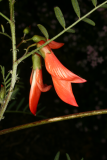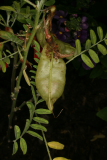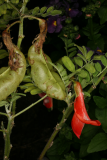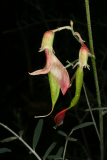Additional notes (click to expand)
Commemorative
The Balloon Pea or Duck Plant was named after James Sutherland (1639–1719). He took on the care of the Trinity Hospital Garden, part of the Edinburgh University Physic Garden, in 1676. He became Regius Keeper by Royal Warrant of William III in 1699. The Physic Garden had been founded in 1670 to grow medicinal plants. So, while Sutherland was not a doctor, he did look after plants for medicines and taught medical students and so I have included him. In fact he started life as the gardener and is described as ‘one of those self-made men of whom Scotland has produced so many and of whom she may well be proud. ... He taught the science of herbs to the students of medicine for small fees, receiving no encouragement than a salary of £20 from the city which did not suffice to pay rent and servants’ wages, to say nothing of the cost of new plants’. When the Physic Garden was nearly washed away with the draining of the North Loch during the siege
of Edinburgh Castle (1689), his plea for financial assistance was rewarded. His salary was raised to £50 and he was able to extend the Garden with purchase of land at Holyrood Palace. He was appointed as the first professor of botany in Edinburgh in 1695. Sutherland continued at Edinburgh until age 66 (1705) publishing Hortus medicus Edinburgensis; or A catalogue of the plants in the Physical Garden at Edinburgh ... (1683) which ‘placed Edinburgh at the forefront of European botany’. His library of herbals, books on botany and numismatics (catalogue in The Bibliotheck 1987;14:30–106) with his collection of Greek, Roman, Scottish, Saxon and English coins and medals were purchased by the Faculty of Advocates and for many years displayed in their library (Editorial, British Medical Journal, 1909).
Oakeley, Dr. Henry. (2012). Doctors in the Medicinal Garden. Plants named after physicians. Royal College of Physicians. page 142
link
Horticulture
Evergreen shrub with slender, erect, twiggy, white-downy stems and pinnate hairy, grey-green leaves, 6-10cm long, each with 13-21 small, oblong to linear-elliptic leaflets on densely white-downy midribs. From late spring to summer, bears racemes, to 8cm long, of pea-like, bright red flowers, 2.5-5cm long. Followed by inflated, broadly ellipsoid to almost spherical, greenish yellow, occasionally red-flushed seed pods, to 5cm long.
Brickell, C. (2003). A-Z Encyclopedia of Garden Plants. Dorling Kindersley. p.1014
Sow seed at 15°C in spring. Root semi-ripe cuttings in summer, with bottom heat. Pests and disease: earwigs and red spider mite may be a problem.
Frost tender; may survive short periods close to freezing (32F).
Cultivation: Under glass, grow in loam-based potting compost with added sharp sand, in full light.
During growth, water moderately and apply a balanced liquid fertilizer monthly. Water sparingly in winter. Outdoors, grow in well-drained, poor to moderately fertile soil in full sun; tolerates dry soils.
Brickell, C. (2003). A-Z Encyclopedia of Garden Plants. Dorling Kindersley. p.1014
Medicinal
Sutherlandia frutescens is called the Cancer Bush in South Africa, and used for cancer and AIDS. Infusions made from the leaves are a traditional remedy for fever, chickenpox, ‘flu, rheumatism, haemorrhoids, diarrhoea, and stomach and liver problems. It also makes an excellent wash for wounds. To quote a paragraph from the South African National Biodiversity Institute website:
It is also used to treat colds, flu, asthma, TB, bronchitis, rheumatism, rheumatoid arthritis and osteoarthritis, liver problems, hemorrhoids, piles, bladder, uterus & women’s complaints, diarrhoea & dysentery, stomach ailments, heartburn, peptic ulcers, backache, diabetes, varicose veins and inflammation ... mental and emotional stress, including irritability, anxiety and depression and is used as a gentle tranquillizer. It is said to be a useful bitter tonic and that a little taken before meals will aid digestion and improve the appetite ... There is as yet no scientific support for the
numerous claims and anecdotes that this plant can cure cancer. Historically Sutherlandia frutescens was first described by Jacobus Breynius in Exoticarum aliarumque minus cognitarum plantarum centuria prima (1678) as Colutea aethiopica, with red to purple flowers, grown in Amsterdam’s gardens for many years, from seed collected at the Cape of Good Hope. Colutea aethiopica was changed by Linnaeus to C. frutescens in his Hortus cliftonianus (1738). This name had appeared in Dodoens’ Pemptades (1583), with a woodcut, but he is describing a Colutea with yellow flowers
which he had called C. linsen in his Cruydtboeck (1554). Neither Lyte, L’Ecluse nor Gerard’s translations of Dodoens carry the name C. frutescens. It appeared again as C. frutescens in Linnaeus’s defi nitive Species plantarum (1753). Sutherlandia frutescens stayed in the genus Colutea until 1812, when Robert Brown (1773-1858), working in Sir Joseph Banks’ herbarium, separated it into its present genus of Sutherlandia. In the Medicinal Garden we grow Colutea orientalis, which has the same inflated, balloon-like seed pods as Sutherlandia, and DNA studies show them to be closely related. The earliest reference to S. frutescens as a cancer cure is to be found over a century ago, in the British Medical Journal (Editorial, 1906).
Oakeley, Dr. Henry. (2012). Doctors in the Medicinal Garden. Plants named after physicians. Royal College of Physicians. page 150
link
Nomenclature
Sutherlandia frutescens is a synonym
http://www.plantsoftheworldonline.org/
Geographical distribution
- Africa, Southern Africa
Lessertia frutescens (L.) Goldblatt & J.C.Manning
Family: FABACEAEGenus: Lessertia
Species: frutescens (L.) Goldblatt & J.C.Manning
Common names: Cancer bush; balloon pea
Distribution summary: S.Africa (Cape)
Habit: Shrub
Garden status: Currently grown
Garden location: Plants in pots (POT), Southern Hemisphere Wolfson bed (N)
Reason for growing: Commemorative, medicinal
.JPG)
.JPG)
.JPG)





.JPG)

.JPG)
.JPG)